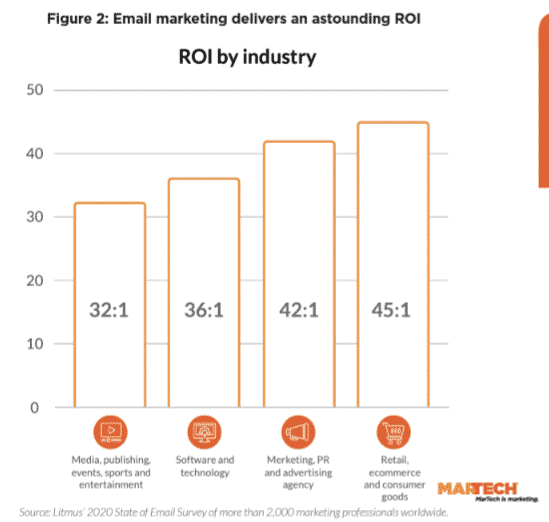All email platform providers send emails, but their technologies – both software and hardware – and approaches for doing so can differ.
Despite being so well-established, email marketing continues to attract more investment. Global spending on email software is expected to climb from $ 4.5 billion in 2020 to $ 14.9 billion in 2027, according to Global Industry Analysts’ predictions. That represents a compound annual growth rate of 13.7% over that period.
Email growth continues to chug along because it delivers consistent and impressive results. For every dollar marketers spend on email marketing, they generate $ 36 in revenue, a Litmus survey of 2,000 email marketers found in 2020. (The company didn’t have ROI numbers for 2021 due to the uniqueness of the year.)
Depending on what industry you’re in, your company’s ROI could be even higher. Agencies in marketing, PR and advertising see a return of $ 42 for every $ 1 they spend on email, and businesses in retail, e-commerce and consumer goods are rewarded with $ 45 in revenue for each dollar spent.

The centrality of data and the need for updated technology
Email may have been around since the dawn of the internet, but the space doesn’t stand still. Email marketing, and the technology that enables it, have evolved to deal with challenges like spam and deliverability and also to take advantage of opportunities, such as the ever-increasing sophistication of data usage for hyper-personalization.
When MarTech surveyed marketers for the 2021 MarTech Replacement Survey, they said technologies for email distribution and for marketing automation (a chief component of which is email), were the two top martech categories they had replaced over the previous 18 months.
The most common reason given for replacing technologies was to take advantage of new and better features in a different solution. And the capabilities that took center stage involved data centralization and other data capabilities.
The latest generation of email technology
When it comes to technology, maturity can be a disadvantage. New businesses can more easily leverage the latest capabilities of software development, while established firms may be saddled with legacy technologies and architectures.
Of course, technology players often introduce new features – some at a higher rate than others. But doing that on top of an aging infrastructure, while also keeping things running for an existing customer base, can be challenging.
The landscape of email marketing players comprises companies that started in the 1990s as well as those launched as recently as 2018.
The biggest recent change in the global environment, the COVID-19 pandemic, increased the importance of digital communications in general and email in particular. Studies by multiple email marketing providers indicate the overall volume of emails sent by marketers rose during the pandemic, as compared with before.
The personalization imperative amid data pressures
Marketers are trying to stand out in a crowded inbox by getting to know their customers and personalizing more messages to achieve greater relevance. But few marketers have the data they need to inform decision-making, a Capgemini survey found.
Many developments are changing the data landscape, especially in data collection. For example, in an effort to safeguard its customers’ privacy, Apple in mid-2021 announced features in iOS, Mac OS and Watch OS that limit the data available to marketers.
The main impact of these changes on email marketers is the decline of the open rate as a meaningful metric. Because of the way emails are cached under Apple’s Mail Privacy Protection, emails appear to be opened when they actually have not been, skewing the results.
As a consequence, email marketing platform vendors are educating their customers and redesigning interfaces to deemphasize the open rate metric. Some have also been developing new reports and metrics to help marketers as they optimize their messaging.
Enterprise email marketing platform capabilities
Email marketing platforms usually offer features for email creation and sending, but consolidation and integrations have added to what one might have once expected. Common capabilities of these platforms include:
- Message design and creation
- Workflow automation and collaboration
- Message previewing
- Email sending
- Deliverability management
- Data management
- Ecommerce capabilities
- Analytics and reporting
- Third-party integrations
- Automation and landing pages
Some providers may offer more advanced capabilities, such as:
- More full-featured customer data platform functionality
- Artificial intelligence and machine learning capabilities leveraged through different parts of the platform
Here’s a breakdown of the top email marketing platform capabilities to look for that can help marketers succeed in their jobs.
Message design and creation
Providers typically offer a library of templates designed to simplify the process of message design and creation. The sophistication of these templates and the interface for using them differ from provider to provider, and most offer the capability for building your own templates from scratch.
These builders usually feature either a drag-and-drop interface or a code-centric option using HTML or MJML, an open-source email-specific markup language created by Mailjet. Many providers let marketers choose from these interfaces and some incorporate technologies that enable interactivity such as AMP for email or CSS.
Workflow automation and collaboration
Some of these standalone designer tools have won customers by developing features that allow users to smooth their workflows – especially where it comes to working within a team or coordinating between a brand and its agency.
Many of the larger platforms also offer capabilities along these lines. For example, solutions oriented toward franchise businesses let licensors provide assets, templates and such to their franchisees to guide and support their local efforts.
Message previewing
Though previewing goes hand in hand with message creation, we’re discussing it separately because there’s so much specialization involved in this part of the process. One of email’s biggest challenges is that recipients view emails on a wide variety of platforms. For each of the platforms that run email software – mobile phones, browser-based inbox providers and desktop clients – there are multiple brands and possible interfaces.
This means the ability to preview how messages look in all of these types of inboxes is an important feature to look for in an email marketing platform.
Email sending
The majority of email platform providers send emails, but their technologies – both software and hardware – and approaches for doing so can differ. This has the most significant impact on marketers sending large volumes of emails or doing sophisticated personalization.
More full-featured vendors may offer capabilities for managing and conducting SMS communications, as well, which have grown in importance in the COVID era, given their role in things like curbside delivery and other time-sensitive messaging.
Deliverability management
Email marketing platform vendors typically do a great deal to ensure the delivery of the messages they send. For example, tools that marketers use to preview emails can also warn them if the content of the email is likely to trigger spam filters so they can make changes before they send it.
Other deliverability measures include putting authentication protocols such as DKIM, SPF and DMARC in place, to reassure inbox providers that messages are not forged. A new protocol, called Brand Indicators for Message Identification (BIMI) has recently been gaining ground. When senders implement BIMI, a brand-controlled logo can appear next to a message in an inbox that supports the feature, adding to the message’s credibility and building brand recognition.
Email marketing platform vendors also build personal relationships with inbox providers, designating specialists on their teams to serve as liaisons with the biggest ISPs. Through these relationships, which often leverage technology integrations to collect feedback, they can keep up with changes and head off issues before they affect clients’ businesses.
Data management
The ways that email marketing platforms allow marketers to capture, analyze and act on data are
the areas of the greatest competition and differentiation between email marketing platforms.
The most sophisticated email marketing platforms, however, go well beyond this by incorporating CDP functionality. These systems gather data from your recipients’ interactions with your emails, but can also append information from a variety of on- and off-line touchpoints, as well as third-party data sources.
Given marketers’ shift to prioritizing first-party data, an email address is often the most valuable information about a customer or prospect, especially because it can lead to gathering additional information.
Most email marketing platforms have tools that help marketers manage list hygiene, eliminating bounces and unsubscribes in keeping with regulations like CAN-SPAM. Some providers may also include tools to reactivate or unsubscribe addresses that have not interacted with your messages for a given period.
More sophisticated applications for data include audience building and segmentation, including the use of artificial intelligence and machine learning to surface insights from big data stores.
Analytics and reporting
At a minimum, email marketing platforms offer reporting on things like delivery rates, clickthrough rates, bounces and unsubscribes. If you’re able to connect the platform to data from the point of purchase, or to other conversion events, you may be able to tie your email messages to specific returns.
E-commerce capabilities
Email is especially valuable to e-commerce, direct-to-consumer and multichannel retailers. Some providers offer functionalities created specifically for integration with e-commerce platforms, which enable personalization for cross-selling and upselling, as well as interactivity to allow purchases directly from an email message.
Third-party integrations
While, for many marketers, email is one of their most important channels, it’s unlikely to be the only one. Therefore, integrations with other marketing and business applications are critical. Most vendors offer integrations to other systems, but workflows are smoother within some interfaces compared to others.
Automation and landing pages
Another feature offered in email marketing platforms is the ability to automate the sending of individual emails or series of messages, such as warm-up series, drip campaigns or messaging triggered by a particular recipient behavior (such as shopping cart abandonment, for example).
Like automation, the creation of landing pages tailored for individual marketing campaigns is another feature typically associated with marketing automation platforms.
The benefits of email marketing platforms
While any but the most nascent of businesses will likely have adopted some approach to email, given its centrality to business in general, adopting an enterprise solution offers many benefits. These may include:
- Data unification across channels. Some email marketing platforms include full-fledged customer data platforms, but, even if they don’t, the customer databases associated with these systems can serve as a single source of truth across an organization. Such unification can provide businesses with a complete portrait of their customers, permitting them to leverage data for marketing, customer service and product development purposes. Platforms can also assist with compliance with CAN-SPAM and other privacy regulations.
- A more unified technology stack overall. Most email marketing platforms offer extensive integrations with other business technologies, allowing companies to more easily work across silos.
- Ability to identify more profitable audiences and segmentation strategies. The unified data trove gives marketers the opportunity to get to know their customers better, and also to identify lookalike audiences by connecting to additional data sources. Artificial intelligence and machine learning capabilities can surface useful insights that marketers may not know to look for.
- More efficient workflows. Every email message that’s meant to be delivered to an audience or segment typically goes through an internal review and approval process. Some email marketing platforms feature the ability to collaborate and obtain approvals within the platform, which is especially helpful for larger more-distributed organizations and those in more regulated industries. Franchises and other multilocation businesses benefit from even more complex systems aimed at sharing useful assets and establishing guidelines, while also allowing those closest to the customers to add valuable customization.
- More personal and efficient communication with customers. Template design combined with data insights and segmentation can allow businesses to deliver more personalized, relevant and timely messaging. Automation and triggered-messaging features allow for more efficiency, as well. When systems include SMS or mobile notification options, this allows businesses to extend communications to those channels.
- Improved deliverability and design of email messages. Email marketing platforms’ deliverability systems – both technological and relationship-oriented – can help businesses ensure their messages make it to the inbox. Once they arrive, design and preview features give marketers more control over how their messages appear, no matter where they are viewed.
- Access to more advanced templating and interactivity. Interactive capabilities via AMP for email or CSS are more easily accessible with the help of email marketing platforms, allowing businesses to create more engaging messages with better return.
- Better ability to measure return on investment (ROI) and more. Data and reporting capabilities can tie email messages to specific business goals, allowing marketers to optimize content and targeting to achieve the best possible results.
The post What is email marketing and how are platforms helping brands succeed? appeared first on MarTech.
(18)




